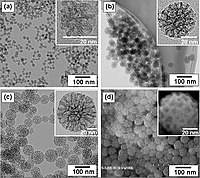
Photo from wikipedia
Dry powder inhaler (DPI) formulations are highly efficient in pulmonary drug delivery because devices for their delivery are portable and aerosolization does not require a propellant. The performance of DPIs… Click to show full abstract
Dry powder inhaler (DPI) formulations are highly efficient in pulmonary drug delivery because devices for their delivery are portable and aerosolization does not require a propellant. The performance of DPIs depends on various physical properties of particles for their manufacture, including aerodynamic diameter, density, particle shape, surface composition, morphology, roughness, and energy. Among these, particle surface properties are the most important factors in determining the interparticulate interactions, which affect the aerosolization efficiency, physicochemical stability, and subsequent in vivo lung deposition efficiency. For a better understanding of the correlation between surface properties and the performance of DPI, there is the need to perform surface characterization of the DPI. This review focuses on analysis of the technology used in the design of DPIs. Thus, the surface crystallinity and polymorphism, surface energy, surface roughness, and changes in solid-state properties of the particles used in DPI formulation will be determined. The commonly used solid-state techniques may not be appropriate for the characterization of DPIs because their detection is mainly limited to the fine changes in physicochemical surface properties such as partial amorphous contents generated on the drug particle surface. Thus, sophisticated technologies with higher detection limits and superior spatial resolutions are required for in-depth characterization. Data obtained from surface analytical techniques can lead to an in-depth understanding of inhalable dry powder at the particle surface. This can provide unique predictive insights into rationally designing inhalable particles with optimal surface properties to provide optimal aerosolization performance for a given DPI formulation.
Journal Title: Journal of Pharmaceutical Investigation
Year Published: 2021
Link to full text (if available)
Share on Social Media: Sign Up to like & get
recommendations!